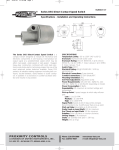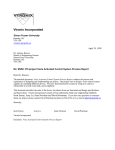Download Design Specifications for an Infant Monitoring System
Transcript
ZenTech Canada Simon Fraser University Burnaby, BC V5A 1S6 [email protected] March 12, 1999 Dr. Andrew Rawicz School of Engineering Science Simon Fraser University Burnaby, BC V5A 1S6 Re: ENSC 370 Design Specifications for an Infant Monitoring System Dear Dr. Rawicz: The attached document, Design Specifications for an Infant Monitoring System, elaborates on the Functional Specifications Document submitted earlier. In this document we describe the methods we will pursue in order to achieve the functional specifications described previously. This document includes several methods being used to obtain and properly process the breathing of an infant. These methods include specific circuit layouts and sensor configurations. This system shall be affordable, and shall not require wires, probes or electrodes that attach to the infant. Scott D. Kulchycki, Rob Trost, Tim Wilder, Mike Sjoerdsma, and A. A. Rhiannon Coppin are the creative and motivated ZenTech engineers. Please feel free to contact any of us via e-mail at [email protected]. Sincerely, A. A. Rhiannon Coppin ZenTech Canada Enclosure: Design Specifications for an Infant Monitoring System http://www.sfu.ca/~rtrost/zentech Design Specifications for an Infant Monitoring System Submitted by: Rhiannon Coppin Scott Kulchycki Mike Sjoerdsma Robert Trost Tim Wilder Contact Information: Rhiannon Coppin email: [email protected] Submitted to: Andrew Rawicz School of Engineering Science Simon Fraser University Steve Whitmore School of Engineering Science Simon Fraser University Submission Date: March 12, 1999 DESIGN SPECIFICATIONS Abstract The Infant Monitoring System is a device that can determine when a sleeping infant stops breathing. The system requires no direct contact to the child and is both inexpensive and simple to use. When a child breathes, the diaphragm muscle relaxes and contracts, creating a noticeable movement of the chest. The Infant Monitoring System utilizes piezoelectric sensors configured in a special manner such that the system sensing takes place completely within the infant’s mattress. The piezoelectric sensors produce a voltage signal when deformed from their original relaxed position. Therefore, the motions of the child’s breathing deform the sensors inside the mattress, creating a signal which is indicative of a breath. Once the signal has been acquired from the infant via the mattress, it must be conditioned. This simply means that the signal will be amplified and majority of noise will be removed. In the IMS, signal conditioning is accomplished using a combination of analog circuits. Finally, the IMS utilizes a Motorola 64HC11 microprocessor to convert the signal into its digital form such that it may be analyzed to determine whether the infant is still breathing. The microprocessor will also drive the user interface, which is a combination of lights, audible alarms, and an alphanumeric display. The following document outlines the implementation of all parts of the IMS and discusses the details of system testing. © 1999 ZENTECH 1 DESIGN SPECIFICATIONS Table of Contents ABSTRACT........................................................................................................................................................... 1 LIST OF FIGURES.............................................................................................................................................. 3 1 GLOSSARY OF TERMS ............................................................................................................................ 4 2 INTRODUCTION........................................................................................................................................ 5 3 SYSTEM OVERVIEW................................................................................................................................ 6 4 SIGNAL ACQUISITION............................................................................................................................. 9 4.1 4.2 4.3 4.4 5 SIGNAL CONDITIONING....................................................................................................................... 13 5.1 5.2 5.3 5.4 5.5 5.6 6 IDENTIFYING SYSTEM ACQUISITION DIFFICULTIES .................................................................................. 9 SOLUTIONS TO SYSTEM ACQUISITION DIFFICULTIES ............................................................................... 9 TYPE OF SENSOR USED FOR SYSTEM ACQUISITION ............................................................................... 10 PES CONFIGURATION ........................................................................................................................... 10 BUFFER 1............................................................................................................................................... 13 60HZ NOISE FILTER............................................................................................................................. 14 BUFFER 2.............................................................................................................................................. 15 AMPLIFIER ........................................................................................................................................... 16 LOW-PASS FILTER ............................................................................................................................... 16 DC LEVEL SHIFTER ............................................................................................................................... 16 SIGNAL PROCESSING AND ANALYSIS............................................................................................. 18 6.1 6.2 SIGNAL SAMPLING ................................................................................................................................ 18 SIGNAL PROCESSING ............................................................................................................................. 18 7 USER INTERFACE................................................................................................................................... 20 8 POWER SUPPLY AND BATTERY BACKUP SYSTEM..................................................................... 22 9 SYSTEM TESTING................................................................................................................................... 23 10 CONCLUSION....................................................................................................................................... 24 © 1999 ZENTECH 2 DESIGN SPECIFICATIONS List of Figures Figure 1 – System Block Diagram ..............................................6 Figure 2 – System Context Diagram...........................................6 Figure 3 – System Stages Detail ................................................7 Figure 4 – Physical Layout..........................................................7 Figure 5 – System Context Diagram (Signal Acquisition) .................9 Figure 6 - PES Mounted on Table ............................................10 Figure 7 - PES Mounted on Table with Elevated Ends.............10 Figure 8 - PES Mounted on Table with Arc...............................11 Figure 9 - PES Mattress Configuration 1 ..................................11 Figure 10 - PES Mattress Configuration 1 ................................12 Figure 11 – Signal Conditioning Stage Flowchart.....................13 Figure 12 – Buffer 1 Circuit Diagram.........................................14 Figure 13 – 60Hz Noise Filter Circuit Diagram..........................14 Figure 14 – 60Hz Noise Filter Frequency Response ................15 Figure 15 – Buffer 2 Circuit Diagram.........................................15 Figure 16 – Amplifier Circuit Diagram.......................................16 Figure 17 – Low Pass Circuit Diagram .....................................16 Figure 18 – DC Level Shifting Circuit Diagram .........................17 Figure 19 – System Context Diagram (Signal Processing).......18 Figure 20 – Flowchart of Signal Processing Operation.............19 Figure 21 – System Context Diagram (User Interface).............20 Figure 22 – User Interface Unit.................................................20 Figure 23 – Alarm and Battery Backup Circuitry.......................21 Figure 24-Schematic for IMS Power Supply.............................22 © 1999 ZENTECH 3 DESIGN SPECIFICATIONS 1 Glossary of Terms IMS - Infant Monitoring System LCD - Liquid Crystal Display LED - Light Emitting Diode PES - Piezoelectric Sensor PSP - Parallel Shaft PES PWVP - PES Weight Variation Problem SBP - Spring Block PES SIDS - Sudden Infant Death Syndrome © 1999 ZENTECH 4 DESIGN SPECIFICATIONS 2 Introduction Infant breathing monitors that are currently available on the market share several common faults: • High system cost • High system complexity • Undesirable invasiveness ZenTech’s IMS is a low cost, “invisible”monitoring solution that allows for great ease of use. This system is intended to be used for monitoring an infant as he sleeps in his crib. By monitoring breathing, the IMS will detect events of sleep apnea, cessation of breathing due to airway obstructions, and cessation of breathing due to the onset of Sudden Infant Death Syndrome (SIDS). Since the IMS makes use of current crib mattress architecture as its basis, it introduces very little cost in addition to that of the purchase of an average spring crib mattress (note that all crib mattresses sold in department stores are FDA and CSA compliant). Since the breathing is monitored with sensors which come mounted inside the mattress cavity, there is no intrusiveness of the system and no complexity in setting up the system. A simple connector from one end of the mattress to the alarm unit is all the caretaker ever sees of the mattress-mounted system. The IMS uses a microprocessor to monitor the infant’s breathing and decide whether the breathing has ceased. Note that the ZenTech system defines 20 second pauses between breaths as a cessation of breathing. The purpose of this document is to describe the design specifications of the IMS. That is, the document explains the implementation of each component of the system in addition to discussing system testing. This document has been prepared by the design engineers of ZenTech Canada for internal reference and for external distribution to Andrew Rawicz, Steve Whitmore, Greg Hall, Jason Rothe, Victor Ting, and other external design consultants. © 1999 ZENTECH 5 DESIGN SPECIFICATIONS 3 System Overview The Infant Monitoring System (IMS) uses the displacement of the surface of the mattress as input. This displacement is caused by the sleeping infant’s chest expansion and contraction. The output consists of an alarm system (LEDs, an LCD, and a buzzer) which is activated when displacment indicative of continued respiration has ceased for more than 20 seconds. Figure 1 shows the system block diagram of the IMS. Infant Monitoring System Alarm System User Input Figure 1 – System Block Diagram Figure 2 displays the IMS system context diagram while Figure 3 details the stages in the system. Note that all of the sensing of the infant is done without the use of any electrodes or other devices that need to be attached to the baby. Signal Acquisition Signal Conditioning Signal Processing Figure 2 – System Context Diagram © 1999 ZENTECH 6 User Interface DESIGN SPECIFICATIONS Signal Acquisition Signal Conditioning PES Array Buffer Filter Amplifier Level Shifter Signal Processing A/D Converter User Interface Level Detection Timing Decision Making LEDs LCD Buzzer Figure 3 – System Stages Detail Figure 4 depicts what the system setup actually looks like. Alarm System and User Interface Mattress Connector Coaxial Cable Baby on Mattress Figure 4 – Physical Layout The IMS is activated by the user connecting the alarm unit to the mattress, plugging the alarm unit into a standard 60Hz 120VAC wall outlet, and pushing the power switch (setting © 1999 ZENTECH 7 DESIGN SPECIFICATIONS the power switch to “on”). A Miniscule displacement of the mattress surface results in bending of the piezoelectric sensors. When a piezoelectric sensor is bent, a voltage difference is generated between its two leads. The voltage signals from each of the many sensors within the mattress are combined, and the time-domain response is sped up via the signal conditioning circuitry. In addition to improving the sensor frequency response, the signal conditioning stage serves to clean the signal, amplify the signal, and offset the signal for use by the microprocessor. The signal is then converted into digital form and sampled by our microprocessor at a rate of 10kHz. Timing, level-detection, and decision making algorithms within the microprocessor determine the current status of the infant. This information is relayed to the user via the system LCD. If the system detects a cessation of breathing, an alarm system consisting of an LED and 85dB 2kHz buzzer will notify the system user (parent or caretaker). Should power fail, the audio alarm will sound, powered by a 9V battery. This will inform the user that the monitor is no longer in proper running mode and should not be relied upon. © 1999 ZENTECH 8 DESIGN SPECIFICATIONS 4 Signal Acquisition The first stage of the system acquires the voltage signals from the leads of several piezoelectric sensors. Figure 5 is the Signal Acquisition Context Diagram. Signal Acquisition Signal Conditioning Signal Processing User Interface Figure 5 – System Context Diagram (Signal Acquisition) 4.1 Identifying System Acquisition Difficulties There are several problems that we encounter when trying to accurately monitor an infant's breathing. The following are difficulties we have already encountered: • Removing ambient noise from the infant's physical movements • Adjusting to varying weights of different children 4.2 Solutions to System Acquisition Difficulties Upon further investigation, we discovered that the removal of ambient noise caused by motion from the infant was unnecessary. One of the major factors that can contribute to an infant's death is the child's inability to move their own body. This lack of strength is apparent when the infant dies from carbon dioxide poisoning. When a child is able to move their own body they will be able to reposition themselves. Because the infant does not have enough physical strength to move herself, clearly, no noise from body movement will be generated. Thus, no compensation for movement is needed. The ability to adjust for various weights is critical for the IMS. SIDS occurs within the first year of a child's life. During this first year, the child's weight will increase and the sensors must be able to accommodate this change. This ability to accommodate for various weights is also extremely important for test purposes. Because, we do not have an infant in the laboratory, we must use a member in the group, Tim Wilder, who weighs approximately 150 pounds. It is our goal to be able to monitor up to a maximum of 150 pounds. We also assume that the child will weigh at least five pounds. This ability to achieve a 145 weight range is dependent on the sensor configuration and will be discussed in further detail throughout this section. © 1999 ZENTECH 9 DESIGN SPECIFICATIONS 4.3 Type of Sensor Used for System Acquisition We investigated several types of signal acquisition techniques and narrowed the field of candidates down to a microphone, strain gauge, or piezoelectric sensor based system. The microphone proved to be too sensitive to external noise and therefore produced a high noise to signal ratio. While investigating the strain gauges we discovered that they were too insensitive to pressure applied to them. The strain gauges needed significant pressure to be used properly. Because of this high pressure necessity, the strain gauges would not be able to monitor small variations in pressure, therefore, making them unusable for the IMS. The piezoelectric sensor (PES) proved to be the most appropriate sensor. The PES outputs a voltage when manipulated (as discussed previously). The PES is also extremely sensitive to small motion variations. 4.4 PES Configuration When we first started investigating the PES configurations, we mounted the sensor directly onto a table as shown in Figure 6. Table Figure 6 - PES Mounted on Table This configuration for mounting the PES proved to be unsuccessful as the response obtained was not sensitive enough. We modified the configuration as illustrated in Figure 6 by elevating the two ends of the PES (see Figure 7). Table Figure 7 - PES Mounted on Table with Elevated Ends This new configuration proved to be significantly better because a greater output was generated for small compressions of the PES. The fact that the configuration produced better results led us to the hypothesis that the PES produces a greater output voltage when it is kinked. To verify this theory, we mounted the PES as shown Figure 8 in so that it made an arc. © 1999 ZENTECH 10 DESIGN SPECIFICATIONS Figure 8 - PES Mounted on Table with Arc This arched configuration produced an extremely good response. We achieved a significant voltage output for pressure applied to the sensor. However, this configuration had a major draw back. The drawback became apparent when we tried to apply a weight to the sensor and obtain a response for pressure changes. When we applied the weight, the PES response was very poor. We determined that this was due to the fact the weight was saturating the sensor. This PES weight variation problem (PWVP) occurred because there was no more space for the PES to flex in response to movement. Essentially, we had recreated the configuration in Figure 6. The results obtained from the initial PES configurations verified that the PES could produce a sufficient voltage for small movements. However, these configurations also proved that accommodating weight variation was going to be a major issue. We decided that the only way to correct for the PWVP was to utilize the springs in the mattress. We constructed a PES configuration as shown in Figure 9. Spacing Block Mattress Spring Figure 9 - PES Mattress Configuration 1 This new configuration, the spring-block PES (SBP) configuration, utilizes the spring coils in the mattress and is able overcome the PWVP. When a weight is applied to the top of the mattress, the sensor is able to move downward without being forced into saturation. The PES is mounted on the spacing block so that the end is just touching the spring coil. By affixing the PES in this way, the PES is able to bend in the middle and thus is sensitive to small movements. The SBP is able to produce a breathing signal with little noise. The next PES configuration we tried is illustrated in Figure 10. © 1999 ZENTECH 11 DESIGN SPECIFICATIONS Metal (shown transparent) Doweling Friction Block Pipe Metal Figure 10 - PES Mattress Configuration 1 This configuration, the parallel shaft PES (PSP) configuration, uses the same concept as the SPB configuration. The sensor is able to move down so as not to become saturated when a weight is applied. The top and bottom metal sheets are attached to the mattress. The two parallel shafts keep the sensor aligned with the friction block. The friction block is simply a piece of wood with small notches cut into one face. These notches provide enough friction for the sensor to move when there is a breathing related movement. However, the friction still allows the PES to move freely downward when a weight is applied. The PSP configuration is able to sense a breathing signal, however, there is a high amount of noise generated. This noise is generated because of the sensitivity of this configuration. The PSP was picking up the vibration of walking on the lab floor over 4 meters away. The PSP shows great promises and we are currently working on new configurations that will reduce the noise produced. When we have created a PES configuration that we are satisfied with, that is, it has a low noise to signal ratio, and is able to accommodate varying weights, we will use an array of these sensors. Depending on the sensitivity of the final design there will be an array of three to ten sensors in the mattress. These sensors will be connected together in the mattress and then connected to the IMS unit via a coaxial cable. © 1999 ZENTECH 12 DESIGN SPECIFICATIONS 5 Signal Conditioning The second stage of the IMS system filters out background noise, transmission noise, and capacitive effects from the acquired voltage signal, amplifies this signal, and outputs a signal with an increased signal-to-noise ratio that is ready for use by the processor. Figure 9 shows the context diagram of this stage. Signal Acquisition Signal Conditioning Signal Processing User Interface Figure 9 – System Context Diagram (Signal Conditioning) The signal conditioning stage consists of six separate analog circuits: • • • • • Buffers (2) 60Hz noise filter Inverting amplifier Low-pass filter DC level shifter The signal conditioning flowchart showing the individual components is illustrated in Figure 11. Signal from Signal Acquisition Stage Buffer 1 60Hz Noise Filter Buffer 2 Amplifier Low Pass Filter DC Level Shifter Output to Signal Processing/Analysis Stage Figure 11 – Signal Conditioning Stage Flowchart 5.1 Buffer 1 The first buffer in the conditioning stage is used to lower the cut-off frequency of the PES used in the mattress (the PES is essentially a voltage source in series with a capacitor). Specifically, the buffer presents a large input impedance, which lengthens the time constant, allowing the sensor to operate at the low frequencies of breathing. Unfortunately, the input impedance of a simple current buffer proved too large for the sensors and caused the buffer output to rail at positive supply. Therefore, it was necessary to place a large but finite resistance in parallel with the buffer input resistance to allow proper operation while still lowering the sensor cut-off frequency. The circuit used for the first buffer is shown in Figure 12. © 1999 ZENTECH 13 DESIGN SPECIFICATIONS Figure 12 – Buffer 1 Circuit Diagram 5.2 60Hz Noise Filter One of the major problems with PES is that the sensors are subject to outside signal interference, especially 60Hz noise. The noise present on the signal delivered by the sensors is due to vibratory noise picked up by the sensors in addition to noise obtained through the wires connecting the sensors to the IMS. It is obvious that with the low signal amplitudes generated by the sensors, noise must be negligible to allow detection of the breathing. To this end, the signal conditioning stage includes an active 60Hz band-stop (notch) filter. The filter diagram is shown below in Figure 13. Figure 13 – 60Hz Noise Filter Circuit Diagram © 1999 ZENTECH 14 DESIGN SPECIFICATIONS Notice that this circuit is a simple RLC circuit that uses an inductor implemented using active elements (we have used the Antoniou inductance simulator). The equivalent inductance of the active elements is C R R R L= 2 1 3 5 . R 2 + R6 Thus, the 60Hz noise filter has an excellent frequency response which is shown in Figure 14. Figure 14 – 60Hz Noise Filter Frequency Response 5.3 Buffer 2 The second buffer in the signal conditioning stage is necessary for input to the amplifier circuit. This is needed because the output resistance of the 60Hz filter is extremely high. That is, if the signal from the filter is connected directly to another load, the signal will be greatly attenuated. To combat this problem, we employed a simple current buffer, which we placed between the filter output and the amplifier input. Figure 15 shows the second buffer circuit used in the conditioning stage. Figure 15 – Buffer 2 Circuit Diagram © 1999 ZENTECH 15 DESIGN SPECIFICATIONS 5.4 Amplifier Because the signal amplitude out of the sensors is low, it is necessary to amplify the signal before any analysis can occur. By placing an amplifier at this point in the conditioning stage, we will amplify the signal but not the noise (as it has been filtered out). We achieve amplification using a negative gain opamp configuration, as illustrated in Figure 16. Figure 16 – Amplifier Circuit Diagram Notice from this diagram that we have a gain of approximately –5V/V. 5.5 Low-Pass Filter Once the signal has reached the output of the amplifier, it has traveled several centimeters on the board and has thus acquired some high frequency noise. To remove the noise, the signal conditioning stage utilizes an RC low pass filter. The circuit we use is illustrated in Figure 17. Figure 17 – Low Pass Circuit Diagram From this diagram, we see that the roll off frequency for this circuit is 100Hz, with a roll off rate of –20dB/dec (single pole transfer function). 5.6 DC Level Shifter Once the signal has passed through the amplifier, it has been cleaned to the point that we can distinguish the breathing of the test subject. However, before processing or analyzing the signal, we need to convert it to levels that are recognized by the 64HC11 microprocessor. Specifically, the signal should be at a DC offset of 2.5V (not exceeding 0V © 1999 ZENTECH 16 DESIGN SPECIFICATIONS or +5V). At the input to the conditioning stage, the signal is at an offset of 0V. To accomplish the necessary 2.5V level shift, we use the circuit shown in Figure 18. Figure 18 – DC Level Shifting Circuit Diagram Notice from this diagram that the output voltage will equal twice the input voltage plus half the negative power supply voltage. By using 5V power supplies, we realize the level shift necessary for the signal to be recognized by the processor. In addition, the +5V rail keeps the output from exceeding the allowed processor input. We will use a simple clamping circuit to ensure the signal does not fall below 0V. Once the signal has been output from the level shifter, the breathing signature of the subject has been cleaned, amplified, and adjusted to the proper DC levels for use by the processor. The signal is now ready to be input to the analysis and processing stage. © 1999 ZENTECH 17 DESIGN SPECIFICATIONS 6 Signal Processing and Analysis The signal processing stage will use the conditioned signal, which is between 0.0V and +5.0V, and convert it to a digital signal for processing and analysis purposes. Figure 19 shows the context diagram highlighting the Signal Processing stage. Signal Acquisition Signal Conditioning Signal Processing User Interface Figure 19 – System Context Diagram (Signal Processing) From our analog signal conditioning stage we will have a signal whose amplitude is representative of the motions of our infant. This signal will be input into our microprocessor using an analog to digital converter, and the processor will then determine the state of the infant. Our signal processing will be performed by an HC11 microcontroller. The reasons we chose the HC11 micro-controller include: • Built in analog-to-digital converter • Low cost • Proven technology • Previous experience using the HC11 • Availability of HC11 evaluation boards from the Engineering Department 6.1 Signal Sampling We will sample the conditioned signal at a reasonably high rate (approximately 10 kHz) relative to frequency content of the conditioned signal. The sampling will be done by the HC11’s built in 8-bit analog-to-digital converter which offers resolution of approximately 20mV using a 0 to 5V input range. 6.2 Signal Processing The signal processing will be performed as shown in Figure 20. The micro-controller will compare each sample to a threshold range. If the signal is outside the threshold, that means that we have detected life signs in the infant, and the system will not go into alarm for at least 20 seconds. If the system operates for 20 seconds in which the input signal never goes beyond the threshold levels, the system will go into alarm indicating that no sign of life is being detected from the infant. © 1999 ZENTECH 18 DESIGN SPECIFICATIONS START Initialise Timer Obtain Sample Yes Sample > Threshold No Timer > 20 sec No Yes Sound Alarm Alarm Reset? Yes No Figure 20 – Flowchart of Signal Processing Operation © 1999 ZENTECH 19 DESIGN SPECIFICATIONS 7 User Interface Once properly installed, all system control and feedback will be through a user interface. Figure 21 shows the context diagram highlighting the User Interface stage. Signal Acquisition Signal Conditioning Signal Processing User Interface Figure 21 – System Context Diagram (User Interface) The user interface will consist of a compact display unit as shown in Figure 22. The unit will consist of an LCD display which will constantly display information corresponding to the time from the last recorded life sign from the infant. The three LEDs will display the general system status: the red LED will illuminate in an alarm condition, the orange in the case of a power failure, and the green should always remain on if the unit is operating correctly. The user interface will include a battery backup to provide power for a lowpower alarm in the case that the system power is lost. The circuitry used to implement the battery backup and alarm system is shown in Figure 23. Alarm LCD DISPLAY Power Failure System Power Power Switch Alarm Silence Button Figure 22 – User Interface Unit © 1999 ZENTECH 20 DESIGN SPECIFICATIONS Figure 23 – Alarm and Battery Backup Circuitry The IMS will be accompanied by a short user manual, describing the system operation and possible system states. © 1999 ZENTECH 21 DESIGN SPECIFICATIONS 8 Power Supply and Battery Backup System The IMS will conform to CSA standards for its power supply. By using a transformer to plug directly to the wall, the need to meet class 1 wiring standards is averted. This transformer will output a 24 VAC signal, which will be wired to the circuit board. Built into the monitoring system will be a bridge rectifier with an accompanying smoothing capacitor, used to translate an AC signal to a DC signal. The DC signal can then be further regulated to the required voltage levels, specifically; +5 V, +15 V, and –15 V. The + 5 V, used to power the microprocessor and most of the logic devices, will be regulated using a LM7805 voltage regulator. The +15 V and –15 V references will be used as supplies for the op- amps in the circuit. The negative rail is necessary due to the possibility that the output of the piezoelectric sensors used can be negative. The LM325N tracking regulator will be used to regulate these voltages. Figure 24 illustrates the schematic for the power supply, with the zener diodes D5, D6, and D7 representing the voltage regulator. Figure 24-Schematic for IMS Power Supply The IMS will also be equipped with a battery backup power supply (circuit shown in Figure 23). This backup will only serve to sound an alarm, notifying the parents that the monitor is no longer active. The choice of battery backup was based upon size, availability, and ease of replacements, as well as the voltage requirements for driving the buzzer in the event of a power failure. © 1999 ZENTECH 22 DESIGN SPECIFICATIONS 9 System Testing In the Functional Specification for the IMS we stated that there would be a 2% tolerance for sounding an alarm when unnecessary. Conversely, we would allow for a 1% tolerance for not sounding an alarm when actually needed. The rest of this section outlines our test methods we will use to ensure this criteria is met. One of the fundamental problems that we have to overcome when trying to test our PES configuration is trying to compensate for various weights. We do not have an infant to help test the system. In light of this previous fact, we have had Tim Wilder be our test subject. Of course, it is obvious that Tim exceeds the weight of an infant. However, we are making sure any PES configuration can overcome the PWVP (as discussed in the signal acquisition stage). We will continue to use Tim as the test subject until we are completely satisfied with a PES configuration. Once satisfied, we will continue testing the system using a test subject who is somewhat lighter than Tim. By using somebody who is lighter, we will be able to verify the PES configuration is able to adjust for different body weights. Clearly, this new test subject will still weigh more than an infant. However, we feel that this testing will prove the concept and functionality of the IMS prototype. For the final test of the IMS we will have to test the IMS on real infants. Testing on many infants will require permission from ethics committees. However, ZenTech feels that we will be able to test the system on infants of company friends and family. The final testing phase is necessary to test the full functionality of the IMS for an actual infant. The testing on an actual infant poses several difficulties that are not present while using Tim as the test subject. With Tim, we are able to ask him to vary his breathing to reproduce certain phenomena (i.e. to stop breathing). With an infant this is obviously not possible. The infant’s breathing will not be a problem to test. The problem arises when we want to verify that the IMS will trigger an alarm when the infant stops breathing. The testing of undesired breathing characteristics will have to be modeled using an artificial test subject. Creating an artificial test subject will require research and added effort, and therefore cannot be achieved within the course period. In summary, the IMS will be tested using Tim Wilder for the test subject until we have decided on an optimum PES configuration. Once we have settled on a configuration, we will verify that the IMS will properly work with a lighter test subject. Using a real infant and artificial test subject will be the final stages of the testing before the final IMS product is delivered. © 1999 ZENTECH 23 DESIGN SPECIFICATIONS 10 Conclusion This document has discussed, in detail, the implementation the ZenTech team has decided to follow. At the time of publishing, this particular approach has yielded favourable results. The individual design decisions that comprise the IMS were made not only in the interest of system integrity, but also with concern to financial issues. We are confident that we have chosen the most efficient and most effective method by which to solve the problem of non-invasive breathing monitoring. In addition, we feel that we have designed a system which will cost very little, considerably less than even the cheapest monitors available now (approximately $100). Our design is also superior to current system because it is less complex to use and requires less user maintenance (the cheapest system currently available uses a sheet which can bunch and shift in the crib). Though this project was originally intended to be for a school course only, we feel that this system will work well enough that it will be marketable in the real world, a challenge the ZenTech team looks forward to. Besides the valuable learning experience real world marketing offers, we feel that providing society with this device would help prevent the tragic deaths of thousands of children each year, the original problem our team set out to solve. © 1999 ZENTECH 24












































